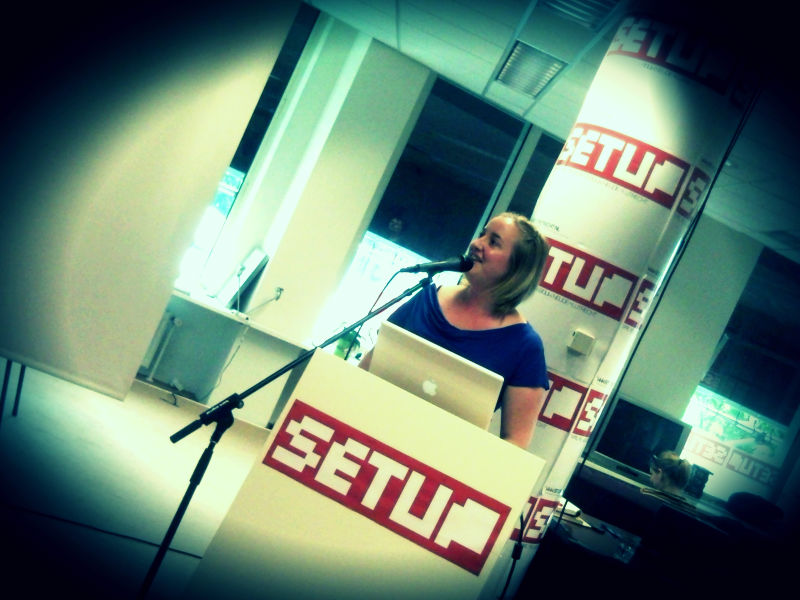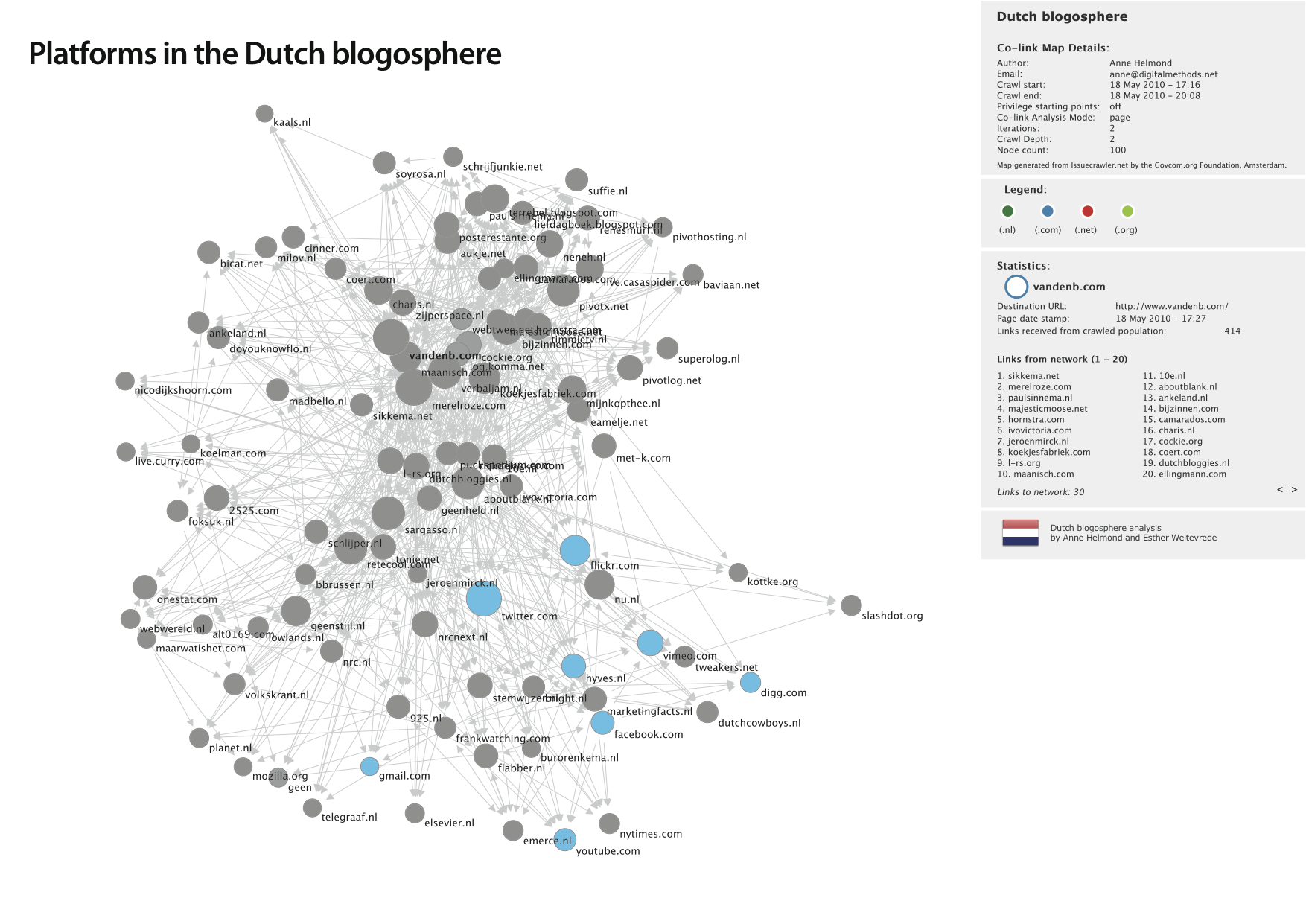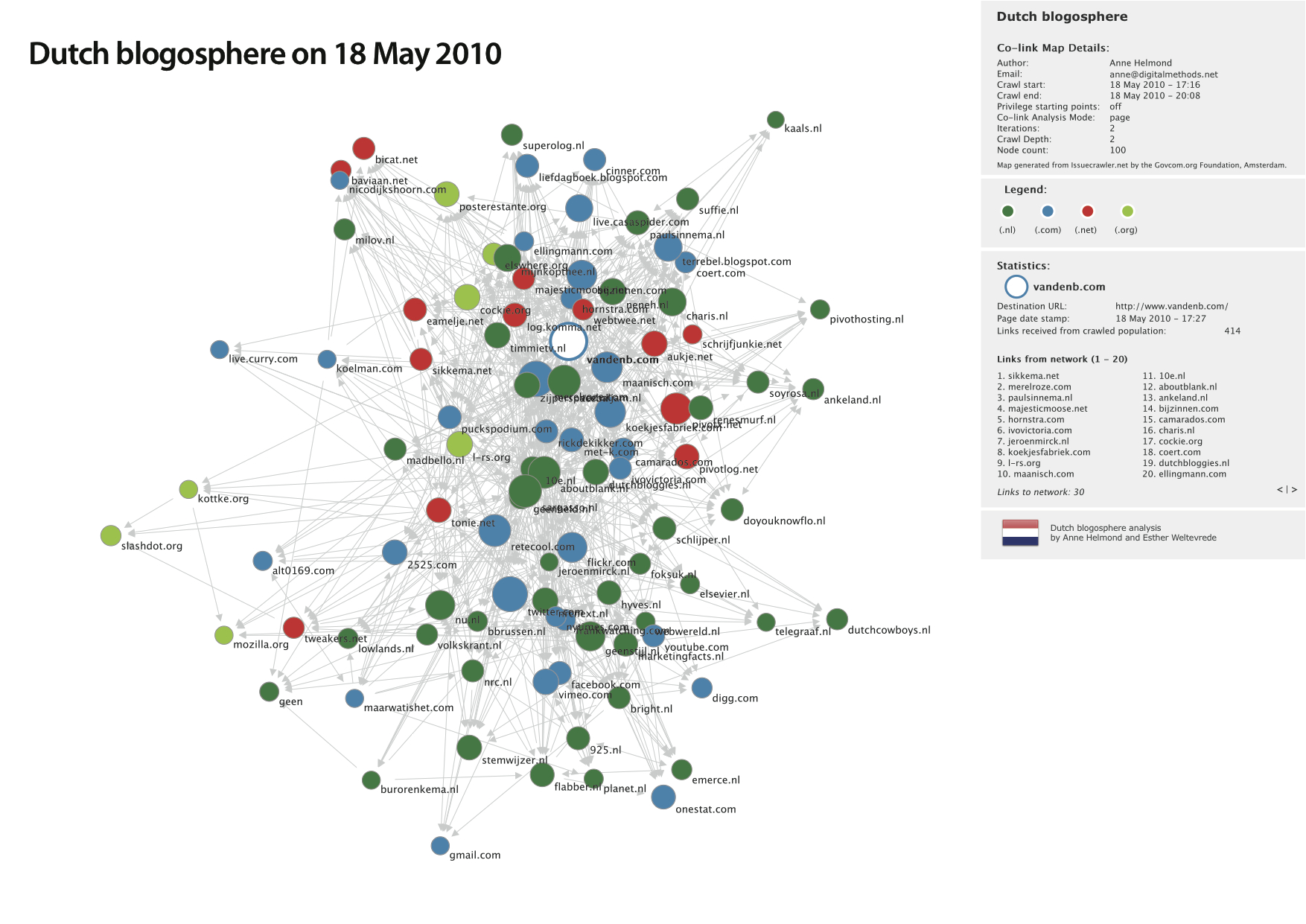
On Tuesday we celebrated the book launch of Frank Meeuwsen’s Bloghelden, a history of the Dutch blogosphere from 1995 to 2005, at SETUP in Utrecht. I was asked to give a presentation on a project Esther Weltevrede and I are working on: Mapping the Dutch blogosphere over time.

In his article ‘Links, Lives, Logs: Presentation in the Dutch Blogosphere’ from 2003 author Frank Schaap distinguishes two types of bloggers in the Dutch blogosphere: the lifeloggers and the linkloggers. ((Frank Schaap, ‘Links, Lives, Logs: Presentation in the Dutch Blogosphere’, Into the Blogosphere: Rhetoric, Community, and Culture of Weblogs < http://blog.lib.umn.edu/blogosphere/links_lives_logs.html> [)) These two types of blogs, the lifelogs and the linklogs, have very specific and different linking patterns. Anno 2010 we can distinguish a new type of blog: the platformlog.
The aim of this study is to map changing blogging practices within the Dutch blogosphere. This may be done by looking at changing linking practices and studying the linking structure of the Dutch blogosphere.
Method
- Create a startlist of URLs. In this casestudy we compiled a list from experts: Arie Altena, Gert-Jan Lasterie, Frank Meeuwsen’s Bloghelden book, Merel Roze’s article on the Dutch Blogosphere in Schrijven Voor Het Web, and Frank Schaap’s article. In the future this list will be supplemented with the Webloglijst (an early semi-manual Technorati) and Nedstat top 1000 weblogs’ statistics.
- Create hyperlink networks over time with the Issuecrawler.
Preliminary findings
Twitter, Flickr, Facebook, Hyves and other social media platforms appear as important actors within the network. In this sample of May 2010 Twitter is the dominant platform in the Dutch blogosphere receiving 34484 links from the crawled population. In 2010 social media platforms receive the most links from the crawled population indicating their prominence on the web and in the blogosphere. Claim: We have moved from a bloggers A-list to a platform A-list consisting of a top three of: Twitter, Flickr and YouTube. The linking structure of the Dutch blogosphere anno 2010 is characterized by social media platforms.
Maps
Click on the maps to download a hi-res PDF file (around 800K).


Further research
- Look up URLs in the Internet Archive and create a special collection by archiving them. Visualize hyperlink networks over time with Gephi.
- How do linking practices change and which clusters emerge? When do the social media platforms arrive?
- Diagnosing the current condition of the early Dutch blogosphere.
Slides in English & Dutch
[slideshare id=4342751&doc=anneblogheldenen-100528074005-phpapp01]
[slideshare id=4342346&doc=annebloghelden-100528064058-phpapp01]
Hmmm leuke nice to know,
Gevoelsmatig denk ik logisch, maar goed om wetenschappelijk onderbouwd te zien.
Verder, in de presentatie wordt gerefereerd naar Facebook door prof. in Indiana. Jullie resultaten geven echter aan dat Twitter de belangrijkste platform is (in periode van 1995 – 2005).
Als we kijken naar de periode van 2005 – 2009…denk je/ jullie dat er in NL ook een verschuiving zal komen richting Facebook? En waarom?
mvg
Jeremy
In ons onderzoek en presentatie is Twitter op 18 mei 2010 het belangrijkste platform in de Nederlandse blogosphere en niet in de periode 1995-2005 zoals je beschrijft. Twitter bestaat pas sinds 2006 :)
Een van de vragen die we met die onderzoek willen adresseren is:
Wanneer komen welke platformen op? Daar valt tevens onder wanneer Facebook in de Nederlandse blogosphere een belangrijke rol gaat spelen. De waarom vraag is dan een derde vraag die aan de beurt komt, maar het is belangrijk om eerst de verschuivingen in kaart te brengen alvorens op zoek te gaan naar verklaringen.
Oh ja, ik zie mijn misvatting. thnx. heb gewoon erover heen gelezen…shame on me :P
Wat betreft de waarom vraag als derde aan de beurt, duidelijk.
Hoe zit het met het inhoudelijke? Kijken jullie ook naar wat voor info wordt gedeeld of puur alleen naar hoe vaak naar een bepaald platform wordt gelinked? Of een combi?
Hebben jullie dus ook bevindingen over welke onderwerpen het meest binnen welke platformen worden behandeld?
Op dit moment wordt er alleen kwantitatief gekeken naar links. Er vindt geen kwalitatieve analyse plaats van wat voor een type link het is, of welke informatie gedeeld wordt. Wel wordt er onderscheid gemaakt tussen blogs en social media platforms.
Deze studie richt zich niet op welke onderwerpen er besproken wordt binnen de platformen. Een link op deze map kan bijvoorbeeld een link naar een Flickr foto pagina zijn, waarbij er dus een onderscheid wordt gemaakt tussen links en objects.